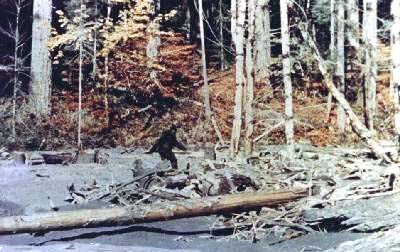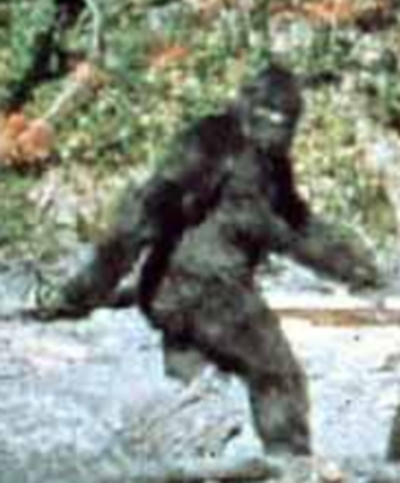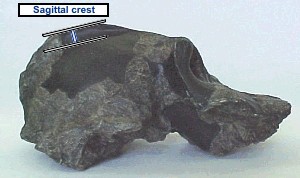40th Nears: Reexamine Frame 352
Posted by: Loren Coleman on June 30th, 2007

As the 40th anniversary of the Patterson-Gimlin footage nears, it is time to re-read a contribution of Darren Naish, Ph. D., formerly of the School of Earth & Environmental Sciences, University of Portsmouth, UK. Naish wrote a thoughtful blog on “Frame 352, and all that.”

In his lengthy essay, in one portion Naish specifically addresses anthropologist John Napier’s criticism of the Patterson-Gimlin footage:
What evidence has been marshaled by those who assert that the film is faked? To date, none. No analysis has been performed which shows that the creature can be explained as a man in a suit. Published objections have either asserted that the animal walks in a manner “consistent in general terms with the bipedal striding gait of modern man” (Napier 1974), or have pointed to the presence of furry breasts, the presence of a sagittal cranial crest in a female, or the presence of breasts in a creature without female-like hips and a waist, as problems showing that the film must have been faked.
These objections are all clearly erroneous (e.g. it is difficult to be confident that furry breasts are somehow impossible – while many primates do sport naked pectoral skin around their nipples and areolae, human breasts are hairy, it’s just that the hairs are very small and thin; sagittal crests are size-related, and only absent in the females of most hominid species because females do not match adult males in the size of their cranial musculature; broad hips and a waist are characters of our species, and not of other hominids or primates). Napier’s objections were vague and have not been supported by those more experienced in biomechanics than he was. Anyway, at the end of his book he writes “One is forced to conclude that a manlike life-form of gigantic proportions is living at the present time in the wild areas of the northwestern United States and British Columbia.”Darren Naish

Additionally, I might add Paranthropus did display sagittal crests in males and females. I consider Sasquatch aligned with Paranthropus, not Gigantopithecus. I have examined this issue here in my blog, “Bigfoot: Gigantopithecus or Paranthropus?”
Pictured above and below is the Black Skull (Paranthropus aethiopicus, specimen KNM-WT 17000), which had the largest sagittal crest known in the hominid lineage (excluding Bigfoot, of course, which, for now, must remain “unknown”).

Paranthropus/Black Skull image courtesy of Skulls Unlimited.
Read Dr. Naish’s complete blog for the rest of what he has to share.
About Loren Coleman
Loren Coleman is one of the world’s leading cryptozoologists, some say “the” leading living cryptozoologist. Certainly, he is acknowledged as the current living American researcher and writer who has most popularized cryptozoology in the late 20th and early 21st centuries.
Starting his fieldwork and investigations in 1960, after traveling and trekking extensively in pursuit of cryptozoological mysteries, Coleman began writing to share his experiences in 1969. An honorary member of Ivan T. Sanderson’s Society for the Investigation of the Unexplained in the 1970s, Coleman has been bestowed with similar honorary memberships of the North Idaho College Cryptozoology Club in 1983, and in subsequent years, that of the British Columbia Scientific Cryptozoology Club, CryptoSafari International, and other international organizations. He was also a Life Member and Benefactor of the International Society of Cryptozoology (now-defunct).
Loren Coleman’s daily blog, as a member of the Cryptomundo Team, served as an ongoing avenue of communication for the ever-growing body of cryptozoo news from 2005 through 2013. He returned as an infrequent contributor beginning Halloween week of 2015.
Coleman is the founder in 2003, and current director of the International Cryptozoology Museum in Portland, Maine.










Wouldn’t it be interesting if none of these fossil hominids were the ancestors of Bigfoot?
Yes, we apparently possess less than a suitcase worth of Gigantopithecus fossils; these could easily have been missed. What other primate lines lie beneath us, undisturbed, or reside in collections, unidentified?
If I may, Loren…
The P-G film does bother me. I had bought roughly two months ago (direct from Hancock House publishers) the volume “Meet the Sasquatch” by Chris Murphy. Excellent book, excellent introduction to the whole subject. And nearly all in color. It held my attention.
On page 52/53 (it actually continues onto page 54, but the stills I wish to highlight are on these two pages) he has enlargements of the P-G film in there. And I took a very good look at these stills.
And I find troubling problems. For instance, frame 307, one can see a “line” running down the back of the creature; in frame 323 this “line” shows also. I have only seen one creature with this apparent “stitched” look–some pointer dogs. I grew up with Hungarian Viszlas, and they had this “stitching”…but this is not a dog we are observing here. Loren, or anyone else, can you come up with photos or other evidence that other primates have this “stitched” hair growth pattern being exhibited? It runs right down the back, along the spine.
Also…
The “buttocks” on this creature does indeed bother me–not for having “junk in the trunk” (to use hip-hop slanguage here) but because it doesn’t appear to be shaped like real buttocks…
Let me explain. Frame 323 shows this part of the anatomy from a a “behind view, and it appears (perhaps an artifact of the film, but I don’t hink so) that it “bunches up”…like cloth would do on a suit…but this is made more manifest in frames 339 (quite clearly) and frame 343 also…
Now I realize we are pushing the 16mm film’s resolution here, but 339 begs the question–that buttocks representation looks “wrong” to me. It is like there is a “back fanny pack” or a stuffed padding-shaped pillow like affair right there (and it isn’t doing what it’s supposed to) , and it looks “wrong” (at least to me)
Now there could be alternative explanations. Certainly I am not a morphology expert.
But if I see something, I will point it out. And I have.
Any comments by anyone else appreciated.
Please post them here.
Not worried about saggital crests, none of that.
It really is problematic that the best photographic evidence for bigfoot is approaching 40 years old. This remains the most depressing fact in regard to the state of modern bigfoot research. This is the best argument against bigfoot for which I have no answer. There needs to be something recorded soon that doesn’t look like a man in a gorilla suit or a dark blob in the shadows.
The “line down the back” is a common feature of primates – seen in monkeys, apes, and humans quite easily. Go visit a zoo, walk on a beach that has a large population of hairy-backed human males, and patiently search for images on the internet. The “line down the back” is there, and is a natural meeting point of two merging patterns of hair growth in primates.
As to buttocks on Bigfoot not looking “normal,” I find that a remarkable statement as we don’t know what a normal Bigfoot looks up close, except via the Bigfoot in the Patterson-Gimlin footage. Why should we use the yardstick of human female buttocks as normal? Also, seriously comparing the female buttocks of the Hottentot and Bushman does show some structural similarities, with reference to how an upright primate carries excess fat in the buttocks.
Thank you Loren for your responses.
We do have an inkling about Sasquatch “butts”…it’s in Meldrum’s book..female, page 112. The “buttocks imprint” is right there. The buttocks there do not indicate or appear to show the type of characteristics seen in the P-G film.
We also have eye-witness drawn illustations–albeit crudely, as one can see one in J. Robert Alley’s “Raincoast Sasquatch” volume on page 74–not at all like what frame 339 shows. The female Sasquatch has a high posterior that sticks out, and yet it doesn’t sag. (I have seen this on human females.) And there is the additional drawing of the William Roe incident drawn by his daughter under his direction (on page 36 of the Chris Murphy book “Meet the Sasquatch”) and that doesn’t show a sagging set of buttocks either.
Of course, this is an exceptionally small sampling. But I am just pointing out that, to me, the trends are not agreeing. Again, what is bothering me is that it’s not that there’s “junk in the trunk” , it’s how it sets there….or sags there…
That’s what I was reaching for in description–a sagging set of buttocks. Looks wrong.
As for hair growth “stitching” down the backs of primates…please post some pictures illustrating this, if at all possible. I don’t recall seeing such hair growth characteristics even in humans…. and I don’t recall seeing back photos of chimps or gorillas demonstrating this.
I am keeping an open mind, but that buttocks section looks wrong in the P-G film. It’s not as noticeable when the film is running, but the stills bring these things out.
Also we, do have the Paul Freeman video footage, as can be seen in its entirety (with sound) on the DVD “Sasquatch: Legend Meets Science”…that is the best footage outside of the P-G film. I think that is very good, yet not quite the rez required, for a Sasquatch film. That was taken in the early 1990s.
Further commentaries welcomed. The more light that is shed, the better everything is.
Even if they do like cinnamon flavored crackers or whatever. LOL
I tend to agree with Chris Noel. Now, dont get me wrong; presenting intelligent speculation is part and parcel with being a cryptozoologist-after all, these are “unknown animals” we’re pondering, arent they? In most cases, we posess varying degrees of evidence; what we DONT have is proof. I’m merely saying that we must avoid being dogmatic about which fossil ape skull matches Sassys’ until we posess a Sas’ skull to make comparisons with.
“”As for hair growth “stitching” down the backs of primates…please post some pictures illustrating this, if at all possible.””
http://www.lizit.com/germany/images/gorilla_1.jpg
Greenmartian- Well, considering the large range of different shaped buttocks among humans, I think it would be hard to come up with what a typical butt is supposed to look like even for humans, let alone sasquatch. There are differences among individuals, sometimes quite dramatic differences, so I am not too concerned with any differences between what is shown in the PG footage and what a sasquatch butt is “supposed” to look like. Considering the wide variety of buttocks for humans, how can we start assuming what is true of sasquatch?
Some further comments…
Thanks Lyndon for posting the link to the gorilla photo. It is much appreciated. However, what one sees in the gorilla photo is not what one sees in the P-G stills. It is a bit different. And when there are dis-similarities, I usually attempt to bring them up to scrutiny (even in my own fields of research and study–completely far away from cryptozoological things).
Mystery man, you’re correct that there is a wide variation on human buttocks…but when you see them, you know what you are seeing is real, even if varied. If you have a copy of Chris Murphy’s book, I encourage you to look at the stills I mention…there is something definitely “wrong”….about the buttocks area.
Loren, this comment addressed to you….
Is it possible to post the three film-still photos from Chris Murphy’s book that I mention? Frames 307, 323 and 339? If that can be done, that would allow perhaps a resolution to these questions in a (hoped for) definitive manner, and much more quickly than otherwise. That would let everyone view the stills in question, and then, everyone could comment on the images and what I am noticing.
If, after that, we can arrive at reasonable explanations for the phenomena that I noticed, then fine.
But those two characteristics I have noted do bother me.
If this is do-able, Loren, thanks in advance.
There is a dark line running down the centre of the back in the gorilla photo. There is a dark line running down the back of the subject in the P/G footage. That’s all we can see and they look pretty similar to me. We can’t see any seam or stitching in the P/G footage. It looks almost exactly like what we see in the gorilla photo.
I’m sorry but any differences you ‘think’ you can see are just wishful thinking. The footage just isn’t pin sharp enough to espouse the subtle differences between the lines in the two subjects.